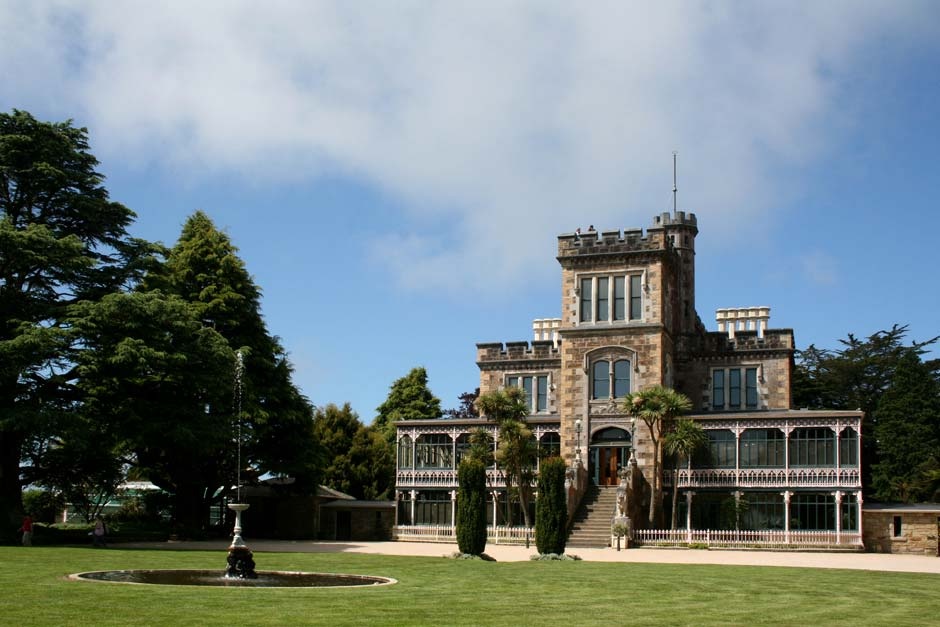
‘The Camp’ and ‘The Cliffs’, Dunedin (1874 & 1876)
Dunedin’s pretentious piles
Dunedin claims two castles, although they are nothing of the sort. William James Mudie Larnach will be forever remembered for two things: taking his own life in Parliament in 1898 as he rebounded from the verge of bankruptcy to the edge of family disgrace, and for this building, ‘The Camp’, or Larnach Castle. It is a fitting monument for a man of whom the Dictionary of New Zealand Biography says, ‘the need to maintain at any cost a show of material success, and to hide any trace of weakness or self-doubt, was a ruling instinct which exacted a heavy toll on his personal happiness’.
The ‘castle’, a 43-room Scots Baronial house, symbolised the wealth and confidence of the Dunedin business community at its peak. R.A. Lawson, normally an architect of taste, supervised it for Larnach and work started on the isolated Otago Peninsula site in 1871. It is an impressive if ill-proportioned lump – ‘Scots Baronial meets Turkish brothel’ as a friend unkindly once put it – of Victorian and Scottish styles based on British plans. Nevertheless, Larnach spared no expense in its execution. Sculptor Louis Godfrey and other artisans wrought magic with the stonework, and the woodwork and plasterwork still excite the senses. Although Larnach moved into ‘The Camp’ in 1874, work on the interior continued for many years and the ballroom was not completed until 1887.
Larnach, born in New South Wales in 1833, was one of the ‘New Iniquity’ who flooded into the province in the 1860s. After mismanaging the Bank of Otago, Larnach plunged his fingers into many pies. He speculated, borrowed and lived life close to the edge. So did his son, who leaped into the bed of his father’s third wife while still living under Dad’s roof. After Larnach’s death the house passed through several hands and experienced many ups and downs, with sheep sheltering in the ruined ballroom at one stage. Since 1967 the Barker family has, with magnificent obsession, slowly and painfully restored the house, outbuildings and grounds as a major attraction.
Closer to town atop wealthy St Clair is ‘The Cliffs’, the city’s other parapeted pile. ‘Lord Concrete’ (Francis William Petre) designed this 21-room mansion in 1876 in what could charitably be called ‘Otago Italianate Concrete’ style for one of Dunedin’s most influential businessmen. Edward Bowes Cargill, the seventh son of Otago’s co-leader Captain William Cargill, arrived in the province in 1858, just three years before the gold rush, but he made up for that by helping John Jones float the Harbour Steam Company. Cargill was a veritable southern octopus. He was a director of the Union Company, Westport Coal, New Zealand Refrigerating, Mosgiel Woollens, National Insurance, Dunedin Water & Gas, Trustees Executors, the Otago & Southland Investment Company and a host of small fry, as well as serving on the boards of many public institutions. In a rush of nostalgia, Dunedin elected him mayor in 1898 to preside over the city’s 50th anniversary celebrations.
In Cargill’s day the colonial elite disported itself at The Cliffs. After E.B. died in 1901 outsiders bought the property. Its later history was as rocky as Larnach’s: cabaret, restaurant, private home, wartime watch post and from the 1970s an empty shell, with the removal of the roof and windows opening it to the elements. Botched by the builder (the stones that went into the concrete were too large), the ruins of ‘Cargill’s Castle’ still cling to the hill, defying the elements and developers alike. Historian Tom Brooking speculates that ‘Captain Cargill may well have found it appropriate that his son’s pursuit of wealth produced a ruined castle while the tall spire of the First Church continues to grace the Dunedin skyline’. Maybe. If E.B. had a fault, it was displaying vulgar ostentation – but one look at some of the hideous excrescences now sprouting up around the old ‘castle’ shows that this failing did not die with him.
Further information
These sites are item number 46 on the History of New Zealand in 100 Places list.
Websites
- Larnach Castle
- Heritage New Zealand List - Larnach Castle
- William Larnach biography – Te Ara
- Cargill’s Castle
- Heritage New Zealand List - Cargill’s Castle
Book
- Fleur Snedden, King of the Castle, David Bateman, Auckland, 1997









Community contributions